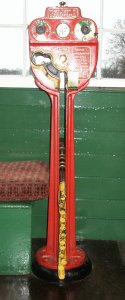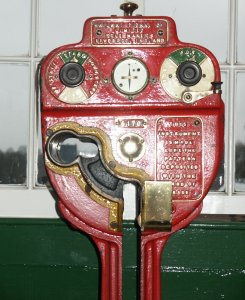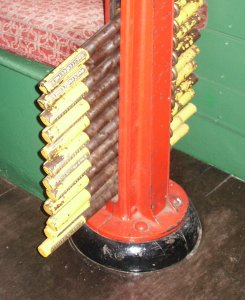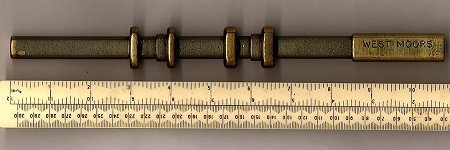Please be aware of our copyright notice. If you have a good reaon for using a photo from this site ask permission from first - it is frequently given.
Southern Signals
Single Line Instruments
| Described below are more of the many forms of Single
Line Instrument that have been used by the Southern railways over the years.
Once again, this is more of an informative introduction than an in-depth
tutorial. These notes are a brief reference to the operation of the
Instruments, there are other requirements to fulfil before a Train may be
allowed into the section.
The Electric Train Staff Instrument |
 |
This is the instrument used for the issuance and return
of the Electric Train Staff. When a Signalman at box A has requested and
been given permission for a train to be sent to box B, the Signalman at B
will hold down a lever on his instrument that will unlock the Instrument in
box A allowing the Signalman there to withdraw one Train Staff. Once the
Staff has been withdrawn it is impossible to withdraw another whilst the first
is out. The Staff may be replaced in either Instrument and once this has been
done, another may be withdrawn from either end of the section. In addition to
locking the Instruments so that no more Staffs may be withdrawn, it is also
usual for the Instrument to be interlocked with the section Starting Signal so
that it may be lowered just once. If for any reason this Signal needs to be
replaced before the train has left, then the Staff has to be replaced and
another withdrawn before the Starting Signal may be pulled again.
photograph by Peter Richards |
| The head of the Instrument. The dial on the right has to
be moved to 'For Staff' by the Signalman withdrawing a Staff, and the
lever with the black handle held down by the other Signalman, before a Staff
may be issued. Whilst the second Signalman is holding down, the galvanometer in
the centre dial will deflect to indicate the Instrument is able to release a
Staff. As soon as the Staff is withdrawn the galvanometer in both Instruments
will return to its normal position. Once the Staff has been withdrawn the dial
on the left may be turned to 'Up Staff Out' or 'Down Staff Out'
as appropriate as a reminder to the Signalman of the state of the Instrument.
Prior to releasing a Staff, the black handled lever may be used for operating
the bell at the other Signalbox providing the dial above is set to 'For
Bell'.
N.B. Not all of these Instruments were equipped with the right-hand indicator. photograph by Peter Richards |
 |
 |
The Staffs are stored in the base of the
Instrument's supporting column. The total number of Staffs in the two
connected Instruments must always equal an even number so if one becomes
damaged and cannot be used, before it is taken away for repair the Lineman has
to remove another Staff, and lock it in a safe place, to balance the
Instruments. If more trains work in one direction than the other, then it will
result in a build-up of Staffs at one end of the section. To overcome this the
Lineman will remove an even number from the full Instrument, making suitable
entries in both his Register and the Signalbox Register, and convey them by
road to the other Instrument.
photograph by Peter Richards |
| One very noticeable thing from the above three
photographs is the sheer size of the Electric Train Staff apparatus - far
larger than those used for the issuance of Tablets or Key Tokens! A
'miniature' version was developed, though not much under half the
size of the 'large' Instrument. The head was not much smaller but the
Staffs were, and were kept in four vertical slots (in a similar fashion to Key
Tokens) as opposed to one.
Right: A Miniature Electric Train Staff that was used between Fordingbridge and West Moors. |

photograph by Chris Osment |
This page was last updated 4 January 2004